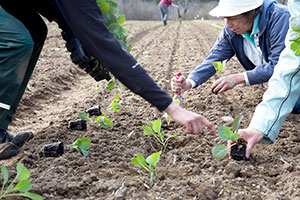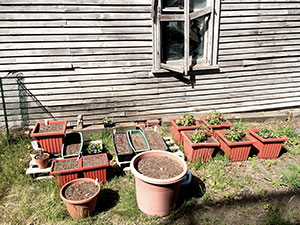
Volunteers at Field of Greens in Lincoln, MA lend their efforts to help produce food for the needy. — Photo by Alexa Gonzalez Wagner
By Patrick McDonagh
“I’m really nervous,” Somerville resident Matt Crawford confesses. “I’ve started a lot of things from seed this year.” Beige, sun beaten, hardware-store plastic pots contain the gardener’s source of anxiety, gently buried beneath a quarter inch of chicken manure.
These geometric pots lay outside behind Food For Free employee Crawford’s home like a grade school geometry lesson, each potted rectangle and circle holding various stages of seedlings. “I’m really nervous that most of it is going to fail but I can still go to a super market,” Crawford rationalizes. “It doesn’t hurt to try and grow your own food.”
Crawford’s weekly trips to the supermarket are not for food shopping. When he is at the supermarket he is busy working pallet jacks and loading donated fresh food onto trucks, the non-profit organization Food For Free’s mission of food rescue. During 2014 Food for Free diverted over 1.3 million pounds of food from the waste stream through the process of food rescue.
Crawford outlines the consumer dilemma that results in otherwise wasted food. “If a tomato or apple gets slightly bruised no one’s going to buy it. The normal consumer won’t buy it. If you’re paying a premium for apples you’re not going to pick the bruised apple, you’re going to pick the really nice looking apple.” Any food bruised or altered aesthetically, including slightly dented cans, will be pulled from supermarket shelves. Sandwiches and prepared foods are removed a day prior or on the date of expiration.
All of the foods are perfectly edible, Crawford assures, but these less than perfect products would have inevitably been the last consumer choice if left for sale.
This is the paradox of food branding: grocers pick only the perfect products for sale at risk of wastefulness, or sell the lot of inventory at varying quality potentially tarnishing their brand. Organizations like Food For Free divert huge amounts of supermarket food waste to those in immediate need. Soon expiring prepared food is trucked directly to needle exchanges and other locations in need the same day of pickup.

More food being grown for the needy. — Photo by Patrick McDonagh
Pallets of food are stacked and left waiting for Crawford and the Food For Free crew to distribute. Food For Free’s distribution network is located within the greater Boston area: Arlington, Boston, Cambridge, Chelsea, Everett, Lynn, Lowell, Malden, Medford, Peabody, Somerville, and Watertown, with a quarter acre of land in Lincoln MA dedicated to growing fresh food for donations.
Crawford’s agriculture background and studies of human geography at Saint Michaels College prompted his interest in nonprofit farming. Studying abroad in Peru provided worldly perspective of agricultural life outside of the United States. This thought process developed near local markets in the city of Cusco. “I came to the realization that in Peru the food travel is a lot more direct from where its grown to people’s mouths,” Crawford said. “The markets are what really made it obvious to me. At the markets they had hundreds of varieties of potatoes. Every vender sold different kinds of potatoes. Then you had the different kinds of tomatoes and peppers and onions and lettuce venders. It was just obvious that this food wasn’t shipped from Mexico to get here. It was a much more direct capitalistic food system whereas the system here in America is subsidized focusing on the large crops. There are very few agricultural companies in America that run a very large percentage of the food production in this country.”
Field of Greens is the quarter acre of land where Food For Free grows fresh donations for the community. Crawford’s foray into nonprofit farming began with an ideal that accessible fresh food is not exclusive to the agriculture economy. A trip to Peru and volunteering on the Field of Greens farm were catalyst to a career in agriculture.
Crawford currently manages volunteers on the farm and the occasional school group. His motivation for leading the school kids is their exuberance. The short stature of a grade-schooler makes an ideal candidate for plucking root vegetables, and their excitement is unparalleled. “The look in a kids face when they pull something out of the ground,” Crawford notes. “There is that carrot that they are used to seeing in their salad, maybe their parents feed it to them for dinner, and then they realize that was underground when it grows.”
Food grown specifically for donation at the Field of Greens can be harvested, distributed, and eaten in the same day; an enticing prospect. The food rescue process is an environmentally invested labor of love for all involved. “Volunteers, kids discovering where their food comes from, adult volunteers and anyone who comes out to work on the farm; I think understanding the effort behind food production in this country can go a long way to understanding hunger in this country,” Crawford said. “If people are going out to a farm and getting their hands dirty they can see how much work it takes to grow food, but also that you can do it with relative ease.”
Volunteer opportunities are available for sign up on Food for Free’s website, reminding city dwellers that tiny cylindrical grocery store carrots are in fact sliced and shaped from a rooted plant.
















Reader Comments